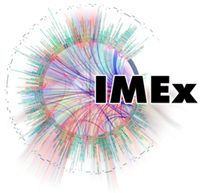irefindex-new
| iRefIndex is a PSIMex partner: |
| fShare this page on Facebook |
| About iRefIndex
iRefIndex provides an index of protein interactions available in a number of primary interaction databases including BIND, BioGRID, CORUM, DIP, HPRD, IntAct, MINT, MPact, MPPI and OPHID. | |
| Download
Download iRefIndex version 8.0 in PSI-MITAB tab-delimited format via FTP. | |
| iRefScape
iRefScape is a plugin for Cytoscape that exposes iRefIndex data as a navigable graphical network. | |
| iRefWeb
iRefWeb provides a searchable web interface to the iRefIndex. | |
| iRefR
An R package providing access to iRefIndex data. | |
| Web-services
iRefIndex PSICQUIC web services are now running on release 8.0 of iRefIndex | |
| Contact info | |
| Information on the iRefIndex database
Source data sets: http://irefindex.uio.no/wiki/Sources_iRefIndex_8.0 Statistics: http://irefindex.uio.no/wiki/Statistics_iRefIndex_8.0 Build process: iRefIndex_Manual Feedback files: README_iRefIndex_Feedback_8.0 Normalization of MI cv terms: Mapping_of_terms_to_MI_term_ids_-_iRefIndex_8.0 Canonicalization: Canonicalization All iRefIndex pages and Archived releases: see below License and disclaimer: see below | |
| Credits, publications, citing, and citations
A listing of those responsible for developing and maintaining the database, iRefIndex related publications, references for source databases and works citing and using the iRefIndex. Details here: iRefIndex_Citations
| |
| DiG: Disease Groups http://donaldson.uio.no/wiki/DiG:_Disease_groups The Disease Groups project groups together phenotypically related disease-gene associations found in OMIM's Morbid Map. The resulting map of disease genes may be used to explore relationships between disease genes in the human protein-interactome. | |
| Bioscape http://bioscape.uio.no/ Bioscape is our in-house text-mining system used to locate gene and protein mentions in PubMed abstracts. |
Contents
- 1 A reference index for protein interaction data
- 2 Long term goals of the iRefIndex project
- 3 iRefIndex availability via download
- 4 Source data for the current build
- 5 iRefWeb: Data availability via web interface
- 6 iRefScape: Data availability via Cytoscape
- 7 iRefR: Data availability via R
- 8 PSICQUIC: Data availability via Web services
- 9 Feedback files
- 10 License
- 11 Disclaimer
- 12 Statistics
- 13 Credits
- 14 Citation
- 15 References
- 16 Citations
- 17 Other Resources
- 18 Contact
- 19 iRefIndex Google Group
- 20 All iRefIndex Pages
A reference index for protein interaction data
iRefIndex provides an index of protein interactions available in a number of primary interaction databases including BIND, BioGRID, CORUM, DIP, HPRD, IntAct, MINT, MPact, MPPI and OPHID. This index includes multiple interaction types including physical and genetic (mapped to their corresponding protein products) as determined by a multitude of methods. This index allows the user to search for a protein and retrieve a non-redundant list of interactors for that protein.
iRefIndex assigns a global unique identifier (rigid) which looks like 'tjWXXjgPyHyT2J6EwED8zK2x18U' to identify interactions that are identical (according to the sequence and taxon ids of the interactors). iRefIndex also assigns similar looking keys to protein interactors. These keys are global meaning they can be generated by anyone using the method described in the paper. This method allows users to integrate their own data with the iRefIndex in a way that ensures proteins with the exact same sequence will be represented only once.
Publications
iRefIndex: a consolidated protein interaction database with provenance. BMC Bioinformatics. 2008 Available here.
iRefWeb: interactive analysis of consolidated protein interaction data and their supporting evidence. Database. 2010 Available here
Literature curation of protein interactions: measuring agreement across major public databases. Database. 2010 Available here
Interaction databases on the same page. Nature Biotechnology. 2011. Available here
PSICQUIC and PSISCORE: accessing and scoring molecular interactions. Nature Methods. 2011. Available here
iRefScape. A Cytoscape plug-in for visualization and data mining of protein interaction data from iRefIndex.Available here
Long term goals of the iRefIndex project
We believe that protein interaction data hold incredible potential for biomedical research. Presently, these data are collected and archived by multiple groups around the world and the number of groups taking part in this work is growing rather than diminishing.
As such, it is important that these databases have the means to effectively exchange and compare data and that they are curating and representing data using similar standards in order to make their data accessible and allow effective use.
To this end, the iRefIndex project has three long term objectives:
- 1) to facilitate exchange of interaction data between interaction databases.
- The iRefIndex paper describes a method for assigning unique and global identifiers to protein interactors, interactions and complexes. This method is independent of the iRefIndex resource and may be used by anyone to facilitate exchange and consolidation of data.
- 2) to consolidate interaction data from multiple sources.
- The method has been used by to index interaction records from multiple sources. The resulting iRefIndex may be used search for the existence of interaction data for any protein regardless of the original resource. Nine interaction databases have been incorporated so far, others will follow.
- 3) to provide feedback to source interaction databases.
- During the process of data consolidation, iRefIndex uses a sophisticated method to keep track of potential problems with source records such as outdated or unfound protein identifiers or incorrectly assigned taxonomy identifiers. These data are provided as feedback files to source interaction databases for correction, clarification or improvements to our own system. This process will help to harmonize data representation and improve the overall quality of interaction records for all source databases. This process will also help source databases to exchange data with one another.
iRefIndex availability via download
All iRefIndex data is provided as a tab-delimited text file in PSI-MITAB format.
Data is available via anonymous FTP at:
ftp://ftp.no.embnet.org/irefindex/data
Username: ftp
Password: enter anonymous or your e-mail address
|
iRefIndex data is now provided as a tab-delimited text file in PSI-MITAB 2.6 format. The format is described at: |
http://irefindex.uio.no/wiki/README_MITAB2.6_for_iRefIndex_8.0
iRefIndex data is provided as a single file or in a number of data sets specific to the organism in which the interaction occurs. See the above link for details.
Source data for the current build
is described at
http://irefindex.uio.no/wiki/Sources_iRefIndex_8.0
iRefWeb: Data availability via web interface
iRefWeb provides a searchable web interface to the iRefIndex. iRefWeb also provides visualization of statistics related to iRefIndex and allows users to compare annotation of the same publication by multiple interaction databases.
http://wodaklab.org/iRefWeb/
Please see the upper right hand corner of the iRefWeb front page for the version of iRefIndex that iRefWeb is using.
The iRefWeb paper is available here.
iRefWeb in the NCBI LinkOut programme
Many Entrez Gene records provided by NCBI contain links to iRefWeb in the LinkOut section, allowing users to consult iRefWeb for related protein interactions when browsing gene information. The software which exposes iRefIndex information to the LinkOut programme can be found on the iRefWeb LinkOut Generator page.
iRefScape: Data availability via Cytoscape
iRefScape is a plugin for Cytoscape that exposes iRefIndex data as a navigable graphical network. See the iRefScape page for documentation and installation instructions.
Sign up for the Google Groups email list (below) to be informed of the official release and updates.
iRefR: Data availability via R
iRefR is an R package that provides access to iRefIndex. Recently submitted to CRAN and also available from ftp://ftp.no.embnet.org/irefindex/iRefR/current/
PSICQUIC: Data availability via Web services
These services provide programmatic access to iRefIndex data as well as many other interaction databases. A publication in Nature Methods describes the services and is available here.
These services are based on a template from the IntAct group at EBI that was developed and implemented by a consortium of authors and interaction database groups. A related interface called PSISCORE, provides programmatic access to interaction data scoring methods.
README PSICQUIC web services for iRefIndex
iRefIndex PSICQUIC web services are now running on release 8.0 of iRefIndex
Feedback files
We provide feedback to source databases about our data integration process. These files are described here :
In some cases, we normalize interaction type and detection method to the MI controlled vocabulary. Details here:
Mapping_of_terms_to_MI_term_ids_-_iRefIndex_8.0
License
Data released on the public FTP site is released under Creative Commons Attribution License http://creativecommons.org/licenses/by/2.5/
Disclaimer
Data is distributed in the hope that it will be useful, but WITHOUT ANY WARRANTY; without even the implied warranty of MERCHANTABILITY or FITNESS FOR A PARTICULAR PURPOSE.
Statistics
Statistics for the iRefIndex include a breakdown of interactors and interactions from each data source.
For statistics on full public dataset (distributed on the FTP site contains) please refer to:
http://irefindex.uio.no/wiki/Statistics_iRefIndex_8.0
Credits
The iRefIndex was developed at the Biotechnology Centre of Oslo, University of Oslo in the Donaldson lab by Sabry Razick and Ian Donaldson. Paul Boddie provides ongoing maintenance and development support. George Magklaras provides systems engineer support and EMBNet Norway provided hardware support.
Citation
iRefIndex has been published and is available here. If you use iRefIndex, please cite:
Razick S, Magklaras G, Donaldson IM: iRefIndex: A consolidated protein interaction database with provenance. BMC Bioinformatics. 2008. 9(1):405 PMID 18823568.
Please also cite the source databases described below. iRefIndex consolidates protein interaction data from...
- BIND [1], [2],
- BioGRID [3],
- CORUM [14],
- DIP [4],
- HPRD [5], [6],
- IntAct [7], [8],
- MINT [9],
- MPact [10],
- MPPI [11] and
- OPHID [12].
iRefIndex uses SEGUID based identifiers to group proteins into redundant groups. The SEGUID algorithm and database are described in [13].
References
Citations
Some studies that have made use of the iRefIndex are listed on the iRefIndex Citations page.
Other Resources
A collection of resources related to finding and working with protein interaction data: Protein Interaction Resources.
Contact
Suggestions, requests and comments are welcome. Please email
ian.donaldson at biotek.uio.no.
Visiting and mail address info is here.
iRefIndex Google Group
Join the iRefIndex Google group and receive announcement emails and discuss issues related to iRefIndex. Sign up at irefindex google group.
All iRefIndex Pages
Follow this link for a listing of all iRefIndex related pages (archived and current).










